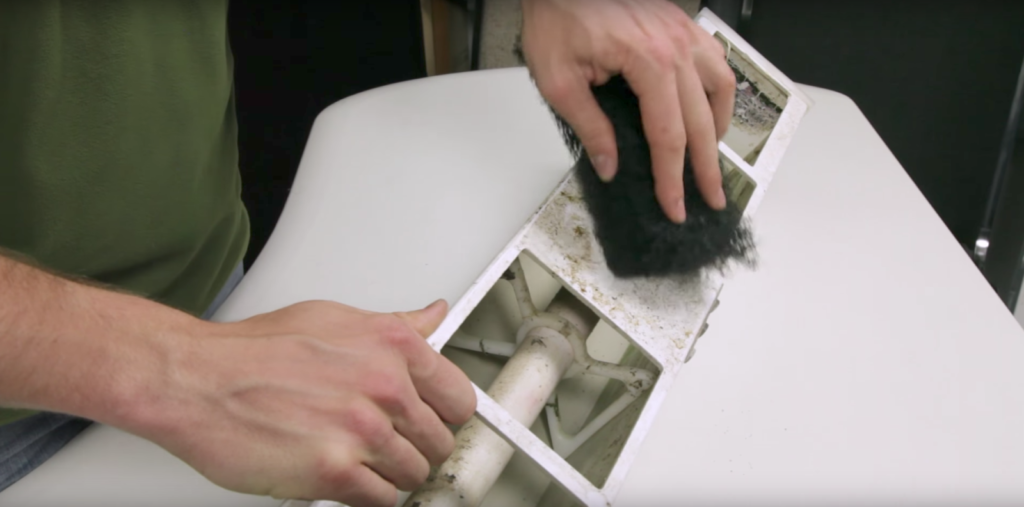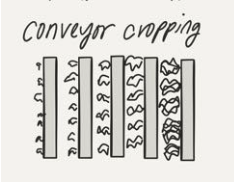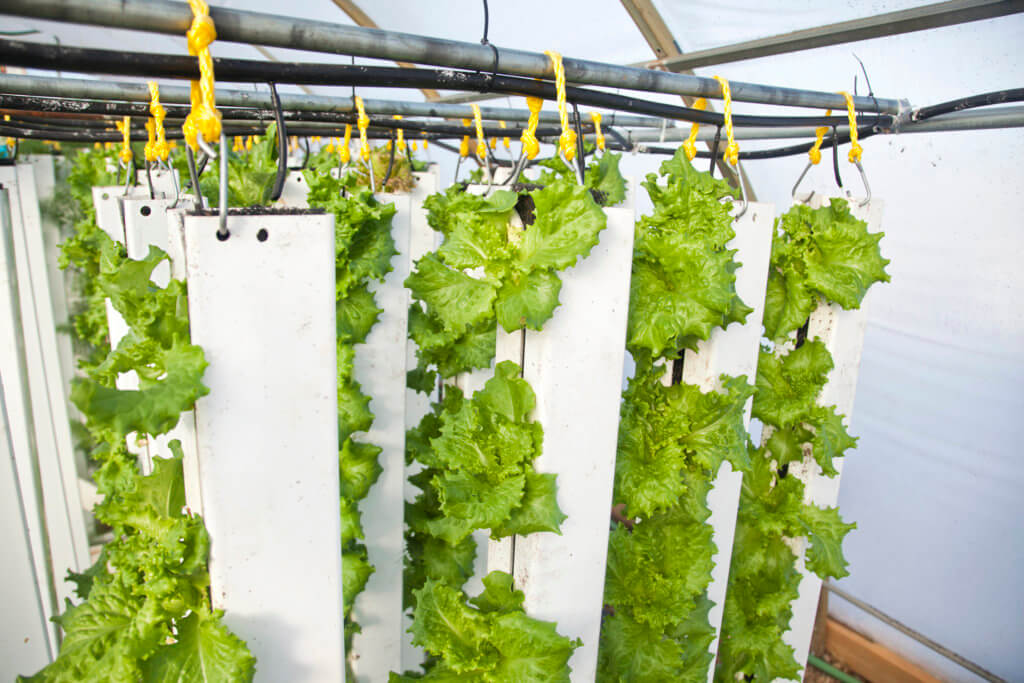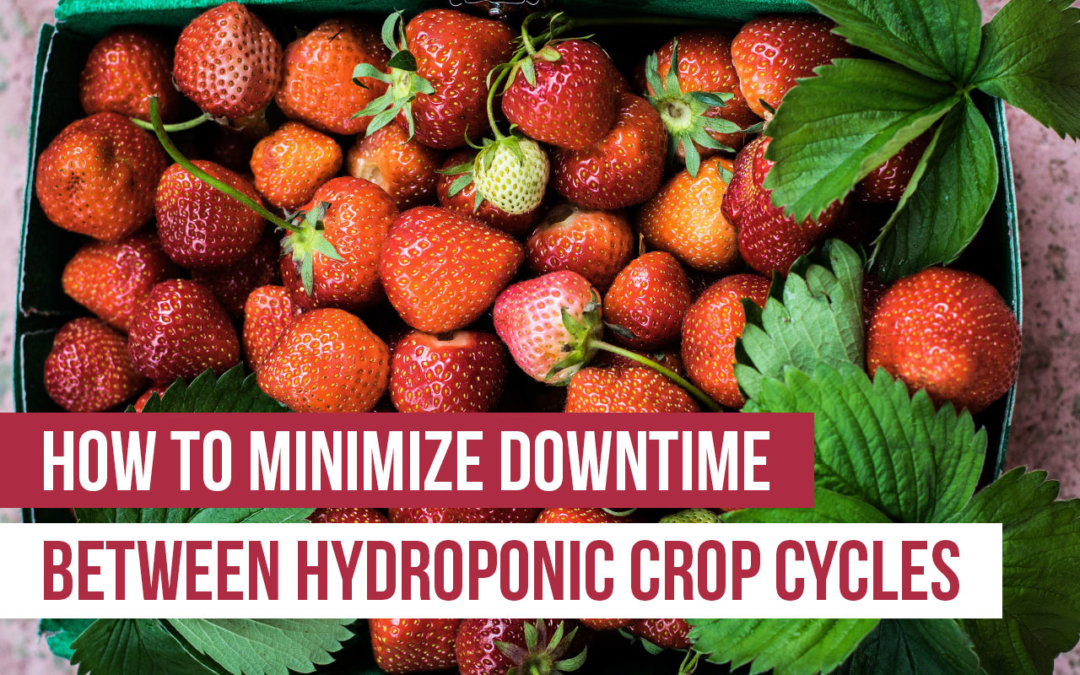 While indoor growers enjoy the benefit of year-round harvests, they can still lose precious time when their system is empty between crop cycles. This is called downtime, and to indoor farmers, it represents an important profit factor.
While indoor growers enjoy the benefit of year-round harvests, they can still lose precious time when their system is empty between crop cycles. This is called downtime, and to indoor farmers, it represents an important profit factor.
This post will help you manage the timing of your farm so that you have as much production time as possible.
So how do you minimize downtime?
The simple answer is to be well prepared, plan in advance, and know the factors that affect crop timing. There are two primary factors that affect crop timing—system cleaning and crop cycles. Timing will largely depend on what exactly you plan to do in between cycles, and whether or not you are prepared with the resources you need.
System cleaning
The first big factor is cleaning and sanitizing your system. We recommend that farmers clean out their systems between crop cycles, but doing so will impact your timing efficiency and require some downtime between cycles. Here’s how to work it into your schedule with as little interruption as possible.
If you plan to do a standard system clean out (see below), you may only need a few hours between cycles. But if you plan to do a deep clean and circulate a cleaning agent, we recommend that you budget a full 24 hours between harvesting and transplanting new seedlings.
A deep clean
There are a couple of ways to effectively deep clean your system: let the cleaning agent circulate for about an hour (minimum), then flush it out. Refill the tanks with clean water and run it overnight. In the morning, flush the system again and refill it with a fresh nutrient solution.
This will allow the cleaning agent (a sterilizer, so use something like diluted food-grade bleach, OxiDate, Bio Green Clean, food-grade hydrogen peroxide, or physan 20) to circulate through everything in your system and kill any bacteria, fungi, diseases, or pathogens, that may have snuck into your system. We recommend farmers do this between each crop cycle since it can only be sterilized when there are no plants in the system. If you do not remove your plants when you sterilize your system, they will die.

Standard cleanout
If you plan to do a standard clean-out (sanitization) of your farm, do so by removing any solids or build-up first. Then flush your system, which will take any solids you missed with it, and refill with fresh nutrient solution. If your system is large, or commercial-sized it may take a full day, but if you’ve got a smaller home system, it may only take a few hours. For more on sterilizing and sanitizing your system, see Ethan’s video/post.
Plan to do this while your new round of seeds is germinating and propagating. This will make your timing more efficient—you’ll harvest the previous crop, clean the system, and be ready to pop the new seedlings in!
Crop Cycles
If you do not decide to clean your system between crop cycles, make sure you’re prepared for transplanting when your previous crop is ready for harvest. Calculate the number of days in advance that you should germinate new seeds so they’re ready to go into the system the day you’re ready to plant. How do you do this?
Write it down on a calendar, or use a Gantt chart—follow these steps:
Step 1: Mark harvest day on a calendar.
Step 2: Add together your crop’s germination time and propagation time. This will give you the number of days prior to harvesting that you should start germinating seeds for the next crop cycle. If you plan to do a deep system clean, add 1 full day. Count back on the calendar, and mark the day you should germinate your seeds and the day you should move them to propagation. The day you transplant into the system should fall either on the day immediately after the harvest of the previous cycle or one day after that, depending on your cleaning plans. Some people get away with harvesting and transplanting on the same day.
Step 3: After your first crop is harvested, and while your second crop cycle is germinating is a great time to clean the system. Mark a day for that.
Lettuce, for example, has a 24 hour germination period, and about a 10 day propagation time, plus the 24-hour clean out. You can time the cleaning with the day you want to harvest. You’ll also want to take into account how long it will take you to harvest. If you have a large farm, it may take you a few days to harvest.

This Gantt chart depicts the timing of two crop cycles. Germination for cycle 2 begins while cycle 1 is still in grow-out so that the seedlings are ready to transplant when cycle 1 is harvested.
Note: your environmental conditions and the varieties you select will all influence crop timing.
Use overlapping crop cycles to harvest a little each week rather than a lot every five
If you’d like more frequent harvests with lower yields, overlapping your crop cycles could be an option for you.
 Overlapping crop cycles refers to having several sections of your farm dedicated to growing the same type of crop on staggered time cycles. One method we have used is called conveyor cropping. In a typical conveyor cropping system, a fifth or a sixth of the towers are planted each week, and the same amount is harvested each week. There are constantly new towers going in, and old towers going out. That means that farmers harvest a little bit each week instead of a lot every 5 weeks, which is useful if they have weekly orders.
Overlapping crop cycles refers to having several sections of your farm dedicated to growing the same type of crop on staggered time cycles. One method we have used is called conveyor cropping. In a typical conveyor cropping system, a fifth or a sixth of the towers are planted each week, and the same amount is harvested each week. There are constantly new towers going in, and old towers going out. That means that farmers harvest a little bit each week instead of a lot every 5 weeks, which is useful if they have weekly orders.
There are several reasons you might want to use a strategy that involves overlapping crop cycles. Say you’re growing basil and selling it to a grocery store. In this case, you probably have a contract that says you promise to deliver a certain amount of basil every week.
Because you harvested basil last week, that section of your farm probably won’t be ready to harvest again this week. If you have another crop cycle set up, you can harvest what you need from different sections of your farm on alternating weeks.
How much you grow and sell will depend on your market demand and the contract you make with your customers. For more information on this, take the Market Research for Farmers course.
Additional considerations—5 more tips for reducing downtime

1. Make a labor plan for harvest
If you’ll be harvesting by yourself, make sure that you have the time to harvest everything you need to in order to have it ready on time for the sale.
2. Know your varieties
Each crop has different cycle timing, so make sure you read up on the unique requirements of the crop. This will inform all of your decisions, from germination to harvest to delivery. In addition, consider what type of harvest the plant will require. For example, lettuce will probably be fully harvested, which will mean that you’d need to replant sooner than if you grew something like basil where you could harvest the same crop cycle multiple times.
3. Choose your harvest technique
How you harvest should be determined by your crop type; some crops allow you to use cut-and-again harvest while others are more suited for a full harvest. A cut-and-come-again-style harvest will probably take longer than a full harvest technique because you’ll be cutting the same plant multiple times rather than taking the whole thing in one go.
4. Factor in the size of your farm
The bigger the system, the longer it will take to harvest. That’s a general rule, even if you have employees working for you. Labor is one of the largest costs of running indoor farms, and that’s because things just take a long time. Ensure that when you are planning for your timing, you take into account how big your system is; take notes on how long on average it takes to do your harvests, and factor it into your crop timing calculations.
This will also inform your decision of what sized sections of your farm you’ll designate for each overlapping crop cycle. If you have ZipGrow towers, for example, you may dedicate ½ or ⅓ of your farm to each cycle.
5. Think about your customers
If your market doesn’t want it, don’t grow it. If your market does want it, and you can grow it well, then budget plenty of time and resources to get them what they want when they want it.
Have questions? Leave them in the comments below
Timing is so important when it comes to planning and making deliveries. The best way to ensure that you have minimum downtime between your harvests is to think ahead. Use the calculations from this post, and take advantage of the time when your seeds are germinating and propagating to get your system ready for their transplant. By minimizing downtime, you’ll make the most of your harvests and get better profits than you’ve seen before!
Leave your questions in the comments below.



hi there!
also wanted to grow lettuce and salads in hydroponics
but dont know what npk (ratio) should i use ?
could you help me with that ?
Hi there!
The best NPK ratio for lettuce and similar greens is generally 8-15-36.